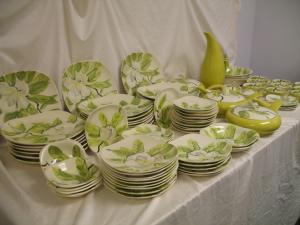There may be a RWCS Chapter near you
Learn more on our Chapters Page.
Membership is only $35 a year and includes six full-color newsletters and exclusive, members only, online content
Question:
 This set of dishes was donated to a thrift store that I volunteer at. The only information that I have so far is that it is from about the 1940′s. There are three different Red Wing marks throughout the set. The pieces are as follows (sizes are approximate): 7-10 1/4" dinner plates 19-10 1/2" dinner plates (some of these have a "burnt" look and crackled glaze) 14-7 3/8" plates 11-6 1/8" plates 4-8 1/4" serving bowls (1 has a chip on backside rim) 2-7 1/4" bowl (1 has a chip on backside rim) 5-5 1/4" bowl (1 has a chip on backside rim) 9-4" dia., 2" tall tea cups 11-6" saucers 3-8 1/2" casseroles (1 has a poorly repaired handle on lid) 2-4 1/2" sugar bowls (1 has a broken handle on lid, piecs missing) 2 creamers (not sure how to measure these!) 1-13" tall pitcher This set is noticably short on bowls, like maybe a box was missed in the donation. I would be very appreciative of any information you have about it (pattern, etc.) and if you have any idea of the value. It’s a very beautiful set in overall good condition, it’s a shame that it isn’t more complete! I also have a number of other pictures if you would like to see them also. Thank you, Cheryl
This set of dishes was donated to a thrift store that I volunteer at. The only information that I have so far is that it is from about the 1940′s. There are three different Red Wing marks throughout the set. The pieces are as follows (sizes are approximate): 7-10 1/4" dinner plates 19-10 1/2" dinner plates (some of these have a "burnt" look and crackled glaze) 14-7 3/8" plates 11-6 1/8" plates 4-8 1/4" serving bowls (1 has a chip on backside rim) 2-7 1/4" bowl (1 has a chip on backside rim) 5-5 1/4" bowl (1 has a chip on backside rim) 9-4" dia., 2" tall tea cups 11-6" saucers 3-8 1/2" casseroles (1 has a poorly repaired handle on lid) 2-4 1/2" sugar bowls (1 has a broken handle on lid, piecs missing) 2 creamers (not sure how to measure these!) 1-13" tall pitcher This set is noticably short on bowls, like maybe a box was missed in the donation. I would be very appreciative of any information you have about it (pattern, etc.) and if you have any idea of the value. It’s a very beautiful set in overall good condition, it’s a shame that it isn’t more complete! I also have a number of other pictures if you would like to see them also. Thank you, Cheryl
Answer: The name of this pattern is Magnolia. It was introduced in 1947 and produced until 1957. The markings on the back changed over the years, and in the early 1950s the size and weight of the dinner plate changed slightly. Most likely this group was assembled by a collector who purchased pieces from several sources, which would explain the different markings and plate sizes. As for the missing bowls, the owner may have forgotten to include them with the donation but more likely never got around to adding the bowls to the collection. The crackled glaze is called crazing and it is not desirable in dinnerware. Improvements in the glaze were made about the same time as plate size change, thus crazing is less of a problem with later plates.
Magnolia sold well in its day and is quite easy to find today. That means it is not as valuable as harder to find patterns; it also means damaged pieces have very little value since better pieces can be readily found. The group of items you describe can’t really be called a "set" of Magnolia; there are too many of some pieces (26 dinner plates) and too few of others (two cups). I’m not sure how your organization plans to sell this group — as a set or piece by piece. A new collector of Magnolia may be interested in buying the entire lot as a starter set, but it wouldn’t appeal to the experienced Magnolia collector who would already have most of these pieces. An antique store would likely sell them by the piece to collectors looking to fill holes in a collection. Retail value for the set as is would be somewhere in the range of $250 to $350. If you sell by the piece, the 13" pitcher is worth $25 to $35, the undamaged casseroles about $25 each, the larger bowls $10 to 15 each, dinner plates and creamers $10 and the remaining pieces would be in the range of $5 to $10.
Larry
